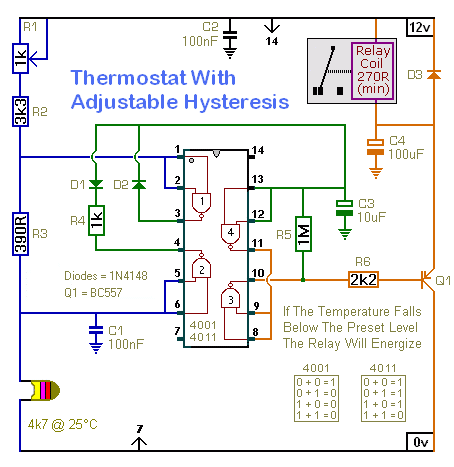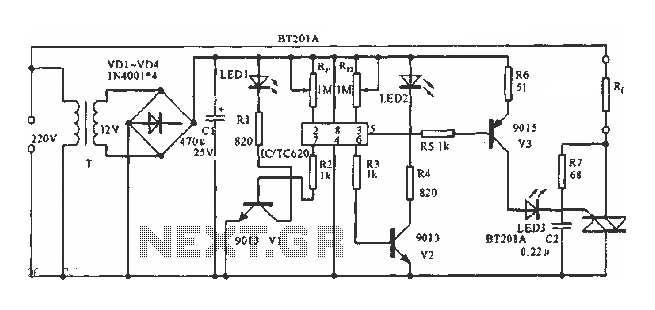
LM319 IC For Thermostat

This circuit illustrates the use of the LM319 integrated circuit in a thermostat circuit diagram. Features include a 2-watt potentiometer for triac power control and a 10 Megaohm resistor.
The LM319 is a dual comparator IC that is commonly used in temperature control applications, such as thermostat circuits. In this configuration, the LM319 can be utilized to compare the temperature sensor's output voltage against a reference voltage set by a voltage divider. The output of the LM319 can then drive a triac, allowing for control of AC loads, such as heating or cooling devices.
In this thermostat circuit, the 2-watt potentiometer serves as a variable resistor that adjusts the sensitivity of the temperature control. By changing the resistance, the user can set the desired temperature threshold at which the circuit will activate or deactivate the connected load. The 10 Megaohm resistor is typically used to limit the current flowing through the input of the LM319, ensuring that the input voltage remains within safe operating levels.
The circuit may also include additional components such as capacitors for noise filtering and diodes for protection against voltage spikes. Proper layout and component selection are crucial to ensure reliable operation and to minimize interference from external sources. This circuit design can be adapted for various applications by modifying the reference voltage and the load characteristics.This circuit shows about LM319 IC For Thermostat Circuit Diagram. Features: 2 watt potentiometer for triac power control, 10 Meg resistance .. 🔗 External reference
The LM319 is a dual comparator IC that is commonly used in temperature control applications, such as thermostat circuits. In this configuration, the LM319 can be utilized to compare the temperature sensor's output voltage against a reference voltage set by a voltage divider. The output of the LM319 can then drive a triac, allowing for control of AC loads, such as heating or cooling devices.
In this thermostat circuit, the 2-watt potentiometer serves as a variable resistor that adjusts the sensitivity of the temperature control. By changing the resistance, the user can set the desired temperature threshold at which the circuit will activate or deactivate the connected load. The 10 Megaohm resistor is typically used to limit the current flowing through the input of the LM319, ensuring that the input voltage remains within safe operating levels.
The circuit may also include additional components such as capacitors for noise filtering and diodes for protection against voltage spikes. Proper layout and component selection are crucial to ensure reliable operation and to minimize interference from external sources. This circuit design can be adapted for various applications by modifying the reference voltage and the load characteristics.This circuit shows about LM319 IC For Thermostat Circuit Diagram. Features: 2 watt potentiometer for triac power control, 10 Meg resistance .. 🔗 External reference





